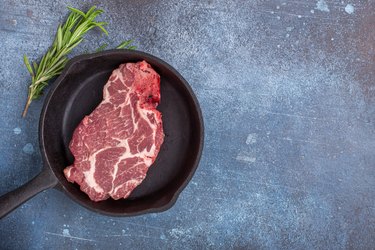Protein Content of a Serving of Beef

Each 1-ounce serving of meat contains 7 grams of protein.
Image Credit: Yingko/iStock/GettyImages
Protein serving size and calories for foods such as beef, canned tuna and peanut butter can vary immensely. Obtaining accurate information is key to balancing foods' nutrition and calorie counts.
Tip
Each one-ounce serving of meat contains 7 grams of protein, notes The Ohio State University Wexner Medical Center. These numbers apply to meats such as beef, pork, chicken, lamb and ham, among others.
Importance of Protein in Diet
Getting enough protein in your diet is key to helping your body run smoothly and efficiently. Every one of your body's cells contains protein in some form, notes the U.S. National Library of Medicine. Protein assists with repair of damaged cells and generation of new ones, among other functions.
Your body's ongoing protein requirements depend on your daily calorie intake. As a guideline, healthy adults should consume 10 percent to 35 percent of their daily calories as protein, says the U.S. National Library of Medicine.
Healthy animal-based protein sources include lean beef or pork, fish, and chicken or turkey without the skin. If you follow a vegetarian diet, low-fat dairy products are also a good bet. Vegetarians and vegans can enjoy nuts and seeds, along with soy protein products such as tofu and tempeh.
Protein Serving Size and Content
Standard servings of meat can vary in their protein counts. A 6-ounce steak is a fairly large beef serving size, and packs a hefty 42 grams of protein (or 7 grams of protein per ounce), states The University of North Dakota Dining Services.
Other beef cuts have a similar protein per ounce number, although the food's total protein content depends on the beef serving size.
A 3.5-ounce chicken breast contains 30 grams of protein, says The University of North Dakota Dining Services. A cooked 4-ounce portion of chicken has 35 grams of protein. Fish is also a good protein source, with each fish steak or fillet containing roughly 22 grams of protein for a 3.5-ounce serving. A 6-ounce can of tuna has an impressive 40 grams of protein.
A 3-ounce serving of ham contains 19 grams of protein, while a 4-ounce pork tenderloin has 29 grams of protein. Bacon provides 3 grams of protein in each crispy slice.
Steak and Chicken Gram Counts
Finding a food's grams of protein per serving isn't as simple as finding the steak protein per ounce number. That's because each food group's magic number applies only to that food group. You may also eat more than the listed serving size, explains The Ohio State University Wexner Medical Center.
For example, let's say you choose a 3-ounce steak, a standard beef serving size, from the meat and meat substitutes group. Each of these foods contains 7 grams of protein per serving, A meat protein serving size is 1 ounce, and if you multiply the 3-ounce protein serving size by 7 grams per serving, you'll consume 21 grams of beneficial protein.
You can also work out the percentage of protein in your serving. The USDA profiles a 3-ounce broiled loin sirloin steak, which has a weight of 85 grams. So, a 1-ounce serving weighs 28.35 grams, and that serving of steak contains 23 grams of protein. By dividing 23 by 85, you determine that the steak contains 27 percent protein.
According to The Ohio State University, a 3-ounce chicken breast contains 21 grams of protein. Preparing it without high-fat, calorie-laden sauces can help you achieve your weight loss or maintenance goals.
Consuming too much healthy protein might mean you exceed your daily calorie count, potentially causing undesirable weight gain. To avoid that result, the Mayo Clinic recommends that you stick to that 3-ounce meat and poultry serving size. As a guideline, a 3-ounce serving of meat is about the same as a deck of cards. Besides keeping your calories in check, you'll also decrease your cholesterol and fat intake.
Source: https://www.livestrong.com/article/255507-what-is-a-serving-size-in-grams-of-protein/
0 Response to "Protein Content of a Serving of Beef"
Post a Comment